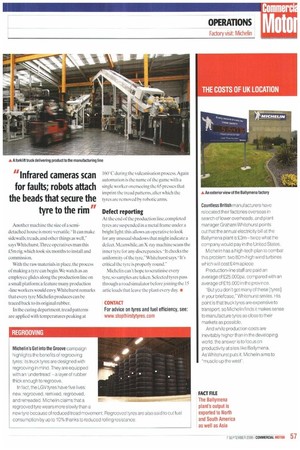Micheiin operates the last truck tyre factory in the UK;
Page 56

Page 57

If you've noticed an error in this article please click here to report it so we can fix it.
Tim Maughan went to Northern Ireland to find out how it's done.
As you would expect, Michelin's vital statistics are impressive. On a visit to the firm's Ballymena plant in Country Antrim we are immediately presented with some facts and figures by Peter Snelling, UK head of communications: • Some 4.5% of the company's turnover is devoted to research and development — more than all the other tyre manufacturers combined.
• Michelin has 74 factories across the globe and runs six rubber plantations.
• A global workforce of 125,000 keeps the wheels (pun intended) turning.
• Michelin employs 4,000 people in the UK. including 1,100 at Ballymena.
Our tour begins in a large meeting room decorated with pictures of Concorde and the Space Shuttle. Michelin made the supersonic airliner's tyres, and continues to supply boots for Nasa's spacecraft.
Plant manager Graham Whitehurst reports that this now is the only LGV tyre factory in the UK — its output is exported to North and South America and Asia as well as Europe. A four-shift system keeps the plant working 24 hours a day, during which time it churns out 4,000 tyres for LGVs,PCVs and light CVs.
Quality control
Much of the process is automated — at the all-important quality-control stage, a f1.8m machine equipped with infrared cameras scans tyres for any hidden faults; robots attach the beads that secure the tyre to the rim. Another machine the size of a semidetached house is more versatile. "It can make sidewalls, treads, and other things as well," says Whitehurst. Three operatives man this £5m rig, which took six months to install and commission.
With the raw materials in place. the process of making a tyre can begin. We watch as an employee glides along the production line on a small platform; a feature many production -line workers would envy. Whitehurst remarks that every tyre Michelin produces can be traced back to its original rubber.
In the curing department, tread patterns are applied with temperatures peaking at l60'C during the vulcanisation process. Again automation is the name of the game with a single worker overseeing the 65 presses that imprint the tread patterns, after which the tyres are removed by robotic arms.
Defect reporting At the end of the production line, completed tyres are suspended in a metal frame under a bright light: this allows an operative to look for any unusual shadows that might indicate a defect. Meanwhile, an X-ray machine scans the inner tyre for any discrepancies "It checks the uniformity of the tyre," Whitehurst says."It's critical the tyre is properly round."
Michelin can't hope to scrutinise every tyre, so samples are taken. Selected tyres pass through a road simulator before joining the 15 artic loads that leave the plant every day. • 'CONTACT For advice on tyres and fuel efficiency, see: www.slopthirstytyres.coni
































































































































































































